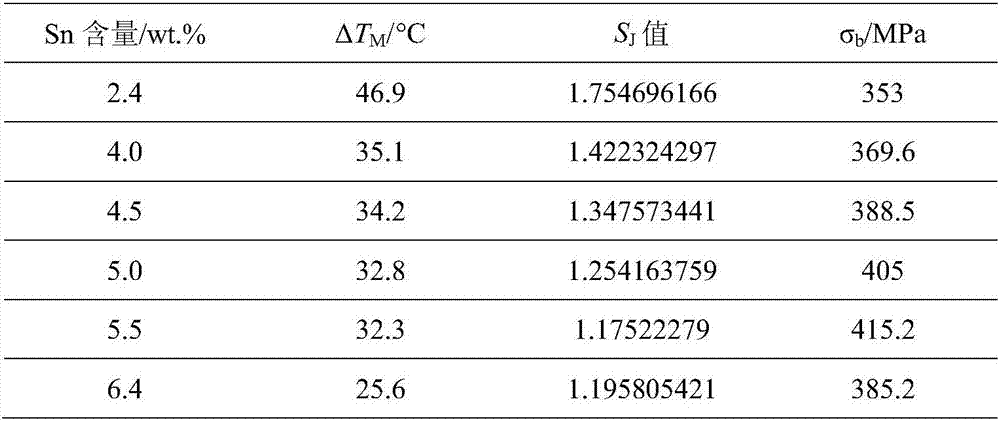Method for predicating regulation and control of low-melting-point elements on mechanical properties of soldering joint
A brazing joint and low melting point technology, which is applied in the field of predicting the mechanical properties of brazing joints controlled by low melting point elements, can solve the problems of predicting changes in joint performance, low accuracy of strengthening curves, and low efficiency, and achieve numerical calculation accuracy High, reduce the test workload, improve the effect of work efficiency
- Summary
- Abstract
- Description
- Claims
- Application Information
AI Technical Summary
Problems solved by technology
Method used
Image
Examples
Embodiment 1
[0028] Embodiment 1: A method for predicting the mechanical properties of Sn element regulating brazing joints (silver solder, AgCuZnSn, Sn content is less than 6.5%; induction brazing, brazing temperature 805 ~ 825 ° C, time 48 ~ 50s), which includes The following steps:
[0029] Step 1: Determine the type of brazing filler metal and base metal material used for brazing joints;
[0030] Step 2: adopt XRF-1800 type X-ray fluorescence spectrometer (XRF) to measure the content W of Sn element in solder M % (mass fraction)
[0031] Step 3: Use STA449F3 Thermal Analyzer (DSC) to determine the silver solder melting temperature range ΔT M ;
[0032] Step 4: The content W of different low melting point elements in step 2 M %Expand 100 times and the melting temperature interval data of step 3 ΔT M Substitute into the forecasting mathematical model S J .
[0033]
[0034] Since only one element Sn is contained in the solder, n=1.
[0035] Step 5: Determine the influence of S...
Embodiment 2
[0039] Example 2: A method for predicting the mechanical properties of In elements to regulate the brazing joint (silver solder, AgCuZnIn, In content less than 5%; induction brazing, brazing temperature 805-820°C, time 48s), its steps and implementation Example 1 is the same.
[0040] In order to verify the accuracy of the prediction method of the present invention, the AgCuZnIn brazing filler metal of 215mg is the 316 stainless steel of solder, 60mm * 25mm * 2.5mm as the base material, and utilizes GP-35 induction heating equipment to heat, insulate and heat the solder and the base material. Cooling; then the MTS universal electronic tensile testing machine tests the tensile strength of the joint (with σ b Express), compare with the prediction calculation result of the present invention. The specific data are shown in Table 2 below:
[0041]
[0042] According to Table 2, with the increase of In content, S J The value gradually decreases, indicating that the tensile str...
Embodiment 3
[0043] Embodiment 3: A method for predicting the mechanical properties of Ga element regulation and control brazing joints (silver solder, AgCuZnGa, Ga content is less than 6%; Induction brazing, brazing temperature 805 ~ 825 ℃, time 45 ~ 49s) method, its steps Same as Example 1.
[0044]In order to verify the accuracy of the prediction method of the present invention, with the AgCuZnGa solder of 220mg as solder, the H62 brass of 60mm * 25mm * 2.5mm is base material, utilizes GP-35 induction heating equipment to solder, base material to be heated, Insulation and cooling; then MTS universal electronic tensile testing machine tests the tensile strength of the joint (with σ b Express), compare with the prediction calculation result of the present invention. The specific data are shown in Table 3 below:
[0045]
[0046] According to Table 3, with the increase of Ga content, S J The value decreases first and then increases, indicating that the tensile strength of the joint i...
PUM
 Login to View More
Login to View More Abstract
Description
Claims
Application Information
 Login to View More
Login to View More - R&D
- Intellectual Property
- Life Sciences
- Materials
- Tech Scout
- Unparalleled Data Quality
- Higher Quality Content
- 60% Fewer Hallucinations
Browse by: Latest US Patents, China's latest patents, Technical Efficacy Thesaurus, Application Domain, Technology Topic, Popular Technical Reports.
© 2025 PatSnap. All rights reserved.Legal|Privacy policy|Modern Slavery Act Transparency Statement|Sitemap|About US| Contact US: help@patsnap.com



